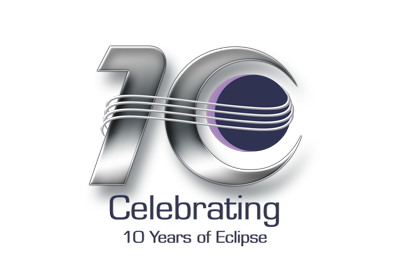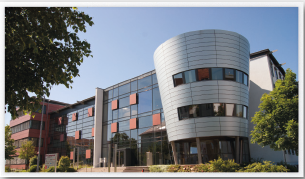Notice: This Wiki is now read only and edits are no longer possible. Please see: https://gitlab.eclipse.org/eclipsefdn/helpdesk/-/wikis/Wiki-shutdown-plan for the plan.
Eclipse DemoCamps November 2011/Kaiserslautern
Contents
Location
Aula of the IT-Campus, Europaallee 10, 67657 Kaiserslautern, Germany
Date and Time
24th of November 2011, starting at 16:00
To give everybody a chance to present their projects, we are limiting the presentations to 15 minutes. The timetable is available here: Media:TimetableDemoCampKaiserslautern2011.pdf.
As compensation for the short timespan, we are offering space for all participants to set up a laptop and to answer any further questions after the main presentation. This way, all visitors can talk in-depth about the themes that particularly interest them.
This will take place in a casual atmosphere with Pfälzer Bufett and home-brewed beer.
We have one more request to all participants: In order to have enough food and drink for everyone, it is important that we know how many people want to come. Therefore, if you haven't registered, or if you are bringing extra people, please let us know.
We are looking forward to a great evening with you.
Deadlines
- 07.11.2011: Submission of suggestions for presentations (i.e. make entry in this wiki, preferably together with a 3-7 sentence abstract.)
- 14.11.2011: Selection of submissions
- 22.11.2011: Suggest demonstrators
Sponsors
- Attensity Europe GmbH, Attensity Europe GmbH
- Eclipse Foundation, Eclipse
- STI e.V., Software Technologie Initiative e.V.
- THESEUS, THESEUS-Forschungsprogramm
- verit Informationssysteme GmbH, verit Informationssysteme GmbH
Organizer
- Torsten Stolpmann, verit Informationssysteme GmbH
- Claudia Könnecke, verit Informationssysteme GmbH
- Ralph Traphöner, Attensity Europe GmbH
- Björn Decker, Attensity Europe GmbH
Presenters
If you would like to present at the DemoCamp, please feel free to add your name and topic to the list. Depending on the number of people interested we may have to limit the number of presenters and time of each demo.
- Igor Novakovic:SMILA 0.9: Ready for big business
Since the new handling of asynchronous workflows has been introduced and all major interfaces got the REST layer in release 0.9, SMILA is now really ready for "the big business" which means handling huge data processing in optimal way by bulking data and offering horizontal and vertical scale-up. The REST APIs also enable easy and performant way of integrating components not written in Java and external systems.
- Dino Coppola: Continuous Requirements Engineering with Eclipse
Tested methods from software development in the area of requirements management can also be realized using Eclipse. Concepts like division of information from representation using models,
revision-safe versioning through use of SVN/CVS, distributed work on the same specifications, integration of third party components like continuous integration and automatic generation of diagrams will be shown in a practical example using the requirements management tool doxo.
- Patrick Reilly, Tobias Schmitt: Embedding Mylyn Connectors in Web-Applications
Using Eclipse-Mylyn, it is possible to use a consistent API to connect all issue management systems or bug trackers which have a Mylyn connector.
Although developed for the Eclipse Workbench, Eclipse-Mylyn is deployable in other applications. We will show which changes were necessary in our experience and what to look out for when integrating Eclipse-Mylyn in a web application.
- Malte Brunnlieb, Philipp Diebold, Thilo Rauch, Peter Reuter: AgileReview – Efficiently reviewing code using the eclipse IDE
Today, especially in the context of agile software development, code reviews become more and more important. Current state of practice of code reviews requires switching between the code and other review tools (e.g. spreadsheets). In order to increase the efficiency of the reviewing processes, AgileReview was developed. The AgileReview plug-in allows direct reviewing and commenting of source code in eclipse. The still ongoing project focuses on usability aspects like easy-to-learn and easy-to-use as well as technical aspects like robustness against code refactoring.
- Werner Keil: UOMo - Typesafe Units of Measurements and its Usage for Open Data
Developers who work with physical quantities (such as developers in the scientific, engineering, medical, and manufacturing domains) need to be able to handle measurements of these quantities in their programs.
Inadequate models of physical measurements can lead to significant programmatic errors. In particular, the practice of modeling a measure as a simple number with no regard to the units it represents creates fragile code. Another developer or another part of the code may misinterpret the number as representing a different unit of measurement.For example, it may be unclear whether a person's weight is expressed in pounds, kilograms, or stones.
- Klaus Mandola: Testing Cloud based Services with Eclipse TPTP
This demonstration shows examples on how to leverage the TPTP framework to deploy, trigger and run tests from remote locations and therefore overcome restrictions usually found in cloud based application scenarios when performing tests."
- Steffen Pingel: Pimp your productivity with Git, Gerrit, Hudson and Mylyn
For tasks, Mylyn already streamlines workflow by providing first-class integration with the IDE. The recent Mylyn project restructuring now enables the same integrated workflows for code reviews, builds and version control systems like Git. We will show how the tools available in the Mylyn project work together to seamlessly integrate development artifacts in Eclipse and provide traceability all the way from the requirement to the final merge into the production branch.
- Holger Staudacher: Dynamic Web Applications with RAP and OSGi
The Rich Ajax Platform (RAP) is an open source web framework run by the Eclipse project. It contains a powerful SWT compatible widget toolkit that allows developing desktop- and webclients from a single code base. While previous versions had been focused on the Equinox world the widget toolkit opens up to the OSGi standard. With the current development stream, RAP integrates seamlessly with the OSGi service platform. This allows to start separate RAP applications in a single process and to add UI contributions dynamically to those applications. In this talk I will give an overview of the technical concepts and show how these technologies can be used to build dynamic web applications. - Dominik Pabst, Thomas Breitbach, Matthias Schmarewski, Sonja Krauß: WHOW - What's hot on Whow: Twitter Ranking realized with SMILA
Whow is a webplatform, which refers its data from a tweetranking. The webapplication follows a certain number of twitterers (based on data from an external application) and evaluate their tweets according to relevance. This produces a ranking of the hottest news at the moment, which also can be personalized. By a theme explorer the user can add more interesting topics and travel back in time per timeline.
All this has been realized in the backend using SMILA.
Please note: All presentations will be held in German
Demonstrators
You created an nice application with eclipse software and show it to others? Just bring your own device and present it at the Demo Camp. Please let us know here what you like to show.
- Werner Keil, Christian Thöns / The Spatio-Temporal Epidemiological Modeler (STEM) is an Eclipse based RCP for modeling the global spread of infectious disease. STEM started in the Eclipse Open Healthcare Framework and was recently promoted as a top level Eclipse Technology project (http://www.eclipse.org/stem/) designed to allow global collaboration on the development of infectious disease models.
Who Is Attending
Please add yourself to this list if you are going to attend this DemoCamp.
- Ralph Traphöner, Attensity Europe GmbH
- Igor Novakovic, Attensity Europe GmbH
- Björn Decker, Attensity Europe GmbH
- Torsten Stolpmann, verit Informationssysteme GmbH
- Claudia Könnecke, verit Informationssysteme GmbH
- Andreas Weber, Attensity Europe GmbH, SMILA
- Peter Reuter, AgileReview
- Thilo Rauch, AgileReview
- Malte Brunnlieb, AgileReview
- Philipp Diebold, AgileReview
- Jürgen Schumacher, Attensity Europe GmbH, SMILA
- Andreas Schank, Attensity Europe GmbH, SMILA
- Luc Müller, I·T·YOU· Ingenieurbüro für E-Business
- Selcuk Akgünlü, I·T·YOU· Ingenieurbüro für E-Business
- Tobias Schmitt, verit Informationssysteme GmbH
- Patrick Reilly, verit Informationssysteme GmbH
- Markus Kopka, Heiler Software AG
- Dino Coppola, Software Ingenieurdienstleistungen
- Alexander Knecht, knecht-IT - Architektur. Entwicklung. Beratung.
- Matthias Dohn, Attensity Europe GmbH
- Werner Keil, Creative Arts & Technologies
- Stephan Hochdörfer, bitExpert AG
- Ralph Müller, Eclipse Foundation
- Eric Andre, omeco GmbH
- Christian Thöns, Eclipse Committer STEM
- Klaus Mandola, verit Informationssysteme GmbH
- Heiner Westphal, verit Informationssysteme GmbH
- Andreas Schlichting, Software Technologie Initiative e.V.
- Askold Zimmermann, Keyshift Inc.
- Markus Knittig
- Dominik Pabst, Attensity Europe GmbH
- Thomas Breitbach, Attensity Europe GmbH
- Matthias Schmarewski, Attensity Europe GmbH
- Sonja Krauß, Attensity Europe GmbH
- Torsten Bur, proALPHA Software AG
- Katrin Lambertus, Attensity Europe GmbH
- Daniel Stucky, Attensity Europe GmbH
- Markus Klinck, Netbiscuits GmbH
- Stefan Zeller, Netbiscuits GmbH
- Manfred Hornberger, Netbiscuits GmbH
- Steffen Pingel, Tasktop Technologies
- Anna Hunecke, TOPdesk Deutschland GmbH
- Martin Krüger, TOPdesk Deutschland GmbH
- Jessica Pfeifer, TOPdesk Deutschland GmbH
- Vitali Baumtrok, Fachhochschule Kaiserslautern
- Udo Walker, ABAS Software AG
- Ronny Händel, ABAS Software AG
- Thilo Mack, ABAS Software AG
- Markus Knauer, EclipseSource
- Kerstin Bach, DFKI


